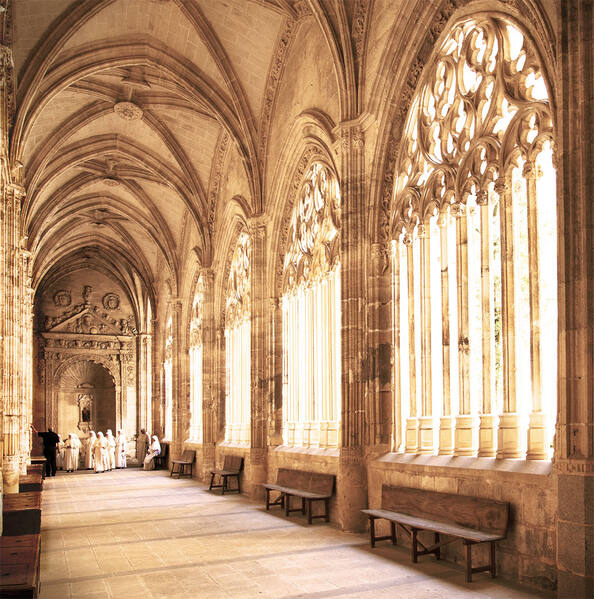Countries<Spain<Castilla y León<Segovia< Ciudad vieja y acueducto de Segovia
Segovia deserved to be inscribed on the World Heritage List in 1985 for bringing together exceptional monuments and illustrating a complex historical reality from Roman times to the Gothic period. Its Aqueduct was one of the most important in the Roman world, not only because of its length, almost 15,000 metres, but also because it is in an admirable state of conservation. Segovia also stands out for the mark left by the different cultures that inhabited it, represented in the monuments, and for being the most abundant Romanesque complex in Europe.
The Roman aqueduct, built around 50 AD, is considered one of the best works of civil engineering in Spain. It was designed to carry water from the river Acebeda to the upper part of the city. The water was first collected in a cistern known as El Caserón, and then carried through an ashlar channel to a second tower (called Casa de Aguas), where it was decanted and desanded, to continue its way, with a gradient of 1%, to the top of the Postigo (the rocky spur on which the city was built around the Alcázar). Thus, until almost to the present day, it supplied water to the city of Segovia, more specifically to its Alcazar. On its route it makes a turn and heads towards the Plaza del Azoguejo, where the monument is in all its splendour. The Aqueduct has a length of 14,956 metres in which there are 166 granite arches and 20,400 stone blocks joined by a balance of forces, which in the highest area reaches 29 metres. The granite ashlars are laid without mortar and have no connecting link; they are kept in balance by a system of thrusts and weights. The aqueduct has remained active throughout the centuries and perhaps for this reason it has reached our days in a perfect state of preservation.
With regard to the occupation of the city of Segovia, the absence of Muslim archaeological remains and the existence of one of the richest Romanesque ensembles in Europe support the thesis of historians who maintain that the city was abandoned after the Islamic invasion and repopulated from the end of the 11th century onwards. From then until the present day it has witnessed the evolution of history.
Segovia mereció la inscripción en la Lista de Patrimonio Mundial en el año 1985 por agrupar monumentos excepcionales e ilustrar una realidad histórica compleja desde época romana hasta época gótica. Su Acueducto fue uno de los más importantes del mundo romano no sólo por su recorrido, de casi 15.000 metros, sino por encontrarse en un admirable estado de conservación. Segovia destaca además por la impronta que dejaron las diferentes culturas que la habitaron, representada en los monumentos, y por constituir el más abundante conjunto románico de Europa.
El Acueducto romano, construido alrededor del 50 d. C., está considerado como una de las mejores obras de ingeniería civil de España. Fue diseñado para llevar agua del río Acebeda a la parte alta de la ciudad. El agua se recogía primeramente en una cisterna conocida con el nombre de El Caserón, para ser conducida a continuación por un canal de sillares hasta una segunda torre (llamada Casa de Aguas), donde se decantaba y desarenaba, para continuar su camino, con una pendiente de un 1%, hasta lo alto del Postigo (el espolón rocoso sobre el que se asentaba la ciudad en torno al Alcázar). Así, hasta casi nuestros días proveía de agua a la ciudad de Segovia, más concretamente a su Alcázar. En su recorrido hace un giro y se dirige hacia la plaza del Azoguejo, donde el monumento presenta todo su esplendor. El Acueducto tiene un recorrido de 14.956 metros en el que existen 166 arcos de piedra granítica y 20.400 bloques de piedra unidos por un equilibrio de fuerzas, que en la zona más alta llega a 29 metros. Los sillares de granito están colocados sin argamasa, no tienen nexo de unión, se mantienen en equilibrio gracias a un sistema de empujes y pesos. El Acueducto se ha mantenido en activo a través de los siglos y quizás por ese motivo ha llegado a nuestros días en perfecto estado de conservación.
Respecto a la ocupación de la ciudad de Segovia, la ausencia de restos arqueológicos musulmanes y la existencia de uno de los más ricos conjuntos románicos de Europa apoyan las tesis de los historiadores que sostienen que la ciudad fue abandonada tras la invasión islámica y repoblada a partir de los años finales del siglo XI. Desde entonces hasta nuestros días ha sido testigo del devenir de la historia.
